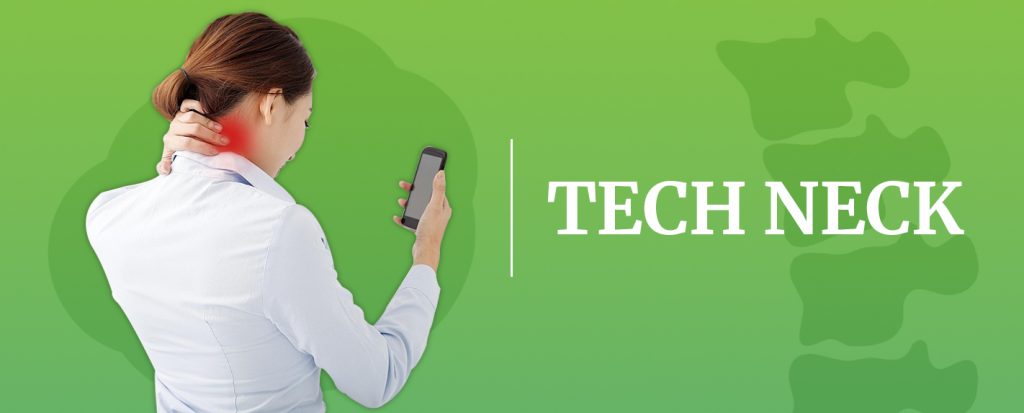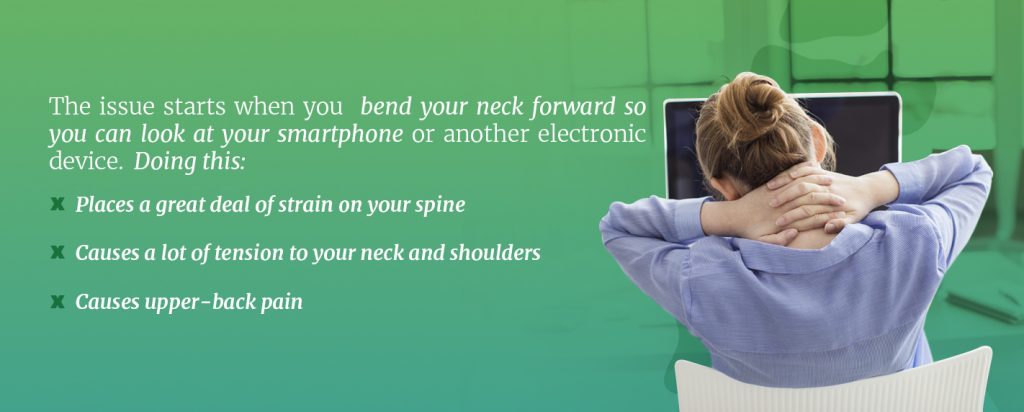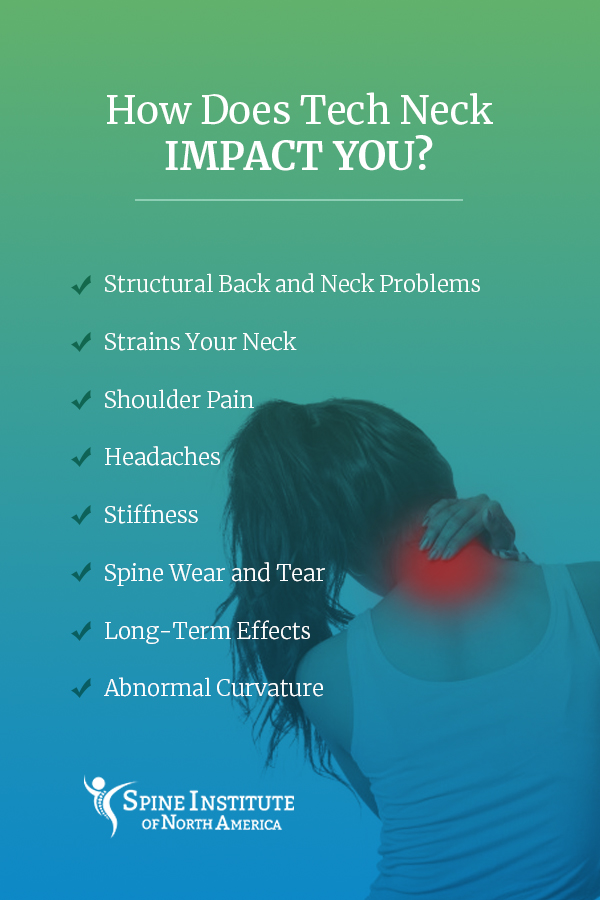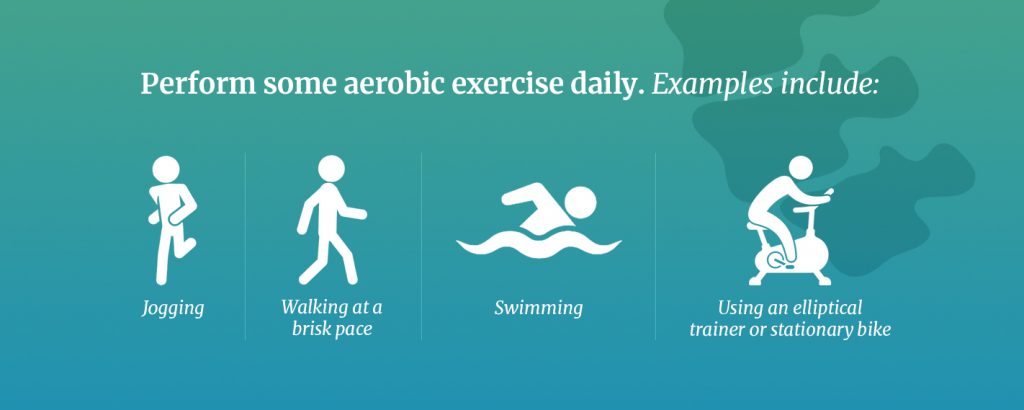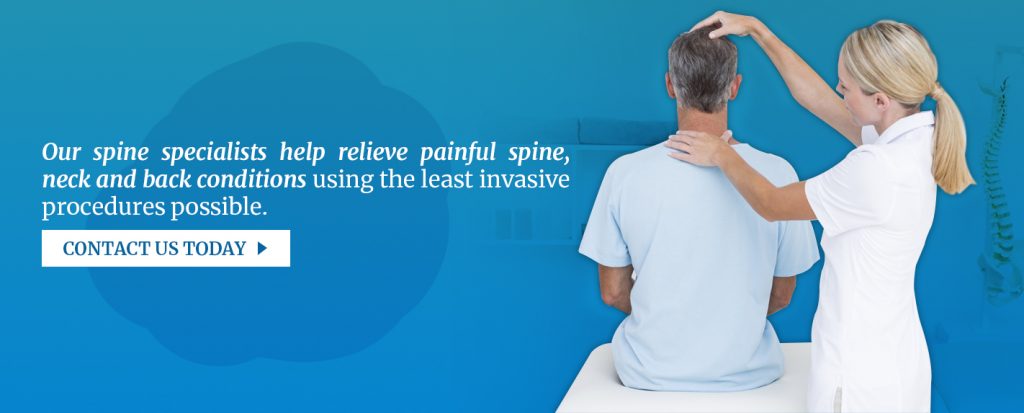This content was medically reviewed by Baher S. Yanni, MD, on June 4th, 2019.
Today, we spend countless hours of our time on smartphones, computers and tablets. Research has shown individuals spend around four hours daily staring at their smartphones — that’s 1,400 hours every year.
And, while we are checking out our latest email, texts or Facebook posts, we’re placing our necks into an overstressed forward curve and don’t realize we’re doing so. To describe this widespread problem, doctors have come up with the term “tech neck.”
What exactly is tech neck, and how does it affect your health? First, you should learn more about your cervical spine to understand it all better.
The Cervical Spine
Your cervical spine is a fancy name for your neck. It’s made up of seven small vertebrae and is the most movable and flexible part of your spine. It makes it so your head can move up and down and turn side to side.
On top of that, your cervical spine has a natural lordotic curvature, which means it bends inward at your neck gently. It helps even out the backward or kyphotic curve of your thoracic spine and helps balance the weight of your head evenly.
Since your cervical spine is highly flexible, it’s also more vulnerable to pain and damage. And, one frequent source of this damage is tech neck.
What Is Tech Neck?
Tech neck, also referred to as cervical kyphosis, is a frequently painful condition that results from the hunchback slouch many individuals employ when they’re using their electronic devices. The issue starts when you bend your neck forward so you can look at your smartphone or another electronic device. Doing this:
- Places a great deal of strain on your spine
- Causes a lot of tension to your neck and shoulders
- Causes upper-back pain
The pain typically builds up over time and might go away after several days or weeks, or it might go away and come back sporadically over many years. The stiff neck and neck soreness could spread down into your mid-back and shoulder blades, maybe even into your arms. It can be sharp at times when you move around or just a dull ache. It could cause headaches. You may feel it when you’re using an electronic device, or it might bother you during the night. Eventually, the pain will distract you and negatively impact your daily life.
When you look straight ahead, the weight of your head is between 10 and 12 pounds. Even if you only bend your neck forward 15 degrees to look at your phone, it doubles the weight of your head, making your head weigh around 27 pounds. Imagine bending your neck at 45 degrees — that’s almost 50 pounds of weight your neck muscles, upper back and shoulders are supporting.
Your muscles must work harder now because you’re beginning to move the center of gravity forward just a little bit. They’re supporting a heavier head, and this will cause some neck pain.
Since individuals rely on their phones so much, they get mentally lost in their texting, games or work, which causes them to forget about their posture. When you’re spending long periods in the tech neck position, for your neck to stay in balance, you’ll need to spend the same amount of time or even more, in the opposite position.
How Does Tech Neck Impact You?
Tech neck could cause:
1. Structural Back and Neck Problems
As your posture becomes worse, the muscles of your upper back stretch out, and the muscles in the front of your body start to become weaker, your neck inches forward and your head feels 10 pounds heavier. Tech neck not only causes structural back and neck problems, it can also create panic and breathing problems. Staying in a forward-rolled posture can impact your breathing profoundly.
2. Strains Your Neck
Using your computer or smartphone all day can cause extra neck strain. A forward head position will cause your muscles to overstretch behind your neck, and the muscles in the front will shorten excessively. Not only is this the place most individuals hold their stress, but it can also contribute to neck soreness, discomfort and pain.
3. Shoulder Pain
On top of the pain in your neck from texting on your smartphone, you may also experience shoulder pain. Since smartphones are small, many individuals tend to hunch their shoulders to hold their smartphone in one hand so they can text with the other. Incorrect ergonomics while you sit in front of your computer can also cause you to hunch over your keyboard. You need to stretch your shoulders out to give them a break periodically and practice forward and backward shoulder rolls.
4. Headaches
You could also experience headaches, either from having your head forward over your shoulders too far while you read your computer monitor or from tilting your head down to read your cell phone’s display. Either of these positions will over-balance your head and could trigger headaches. Instead, try lifting your phone at eye level and adjusting your seat so you’re sitting upright and you’re at eye level with your computer monitor.
5. Stiffness
Inflammation and stress of your connective tissues and neck muscles can cause stiffening or hardening of tissues and limit the rotation in your neck.
6. Spine Wear and Tear
The more people continue relying on their handheld electronic devices, the more it harms their postural health as they shift in their default “head down” posture repeatedly every day for long periods. It can cause long-term cervical spine wear and tear and degeneration. It could also cause the need for spine surgery.
7. Long-Term Effects
You could experience long-term effects, such as:
- Tension headaches
- Herniated discs in your cervical spine
- Neck sprains, similar to injury from whiplash
What initially happens is that your muscles have to strain to hold up your head. When your muscles tighten, it adds more pressure on your discs, making them wear out more quickly. Your weakened discs could then bulge or even rupture. If a ruptured disc pinches one of your nerves, you could experience weakness, pain or numbness in your arm that could require surgical treatment.
8. Abnormal Curvature
The forward bending of looking at your screen, if left unchecked, could become permanent. You could develop an irreversible hunch-backed appearance.
Tips to Prevent Tech Neck
Below are some ways you can prevent tech neck.
1. Raise and Position your Screen Higher
To avoid bending your neck down or sloping your head forward, hold your phone close to eye level. If holding the screen higher causes your arms to become tired, buy a holder that elevates your device or prop your arms up comfortably by resting your elbows on a tabletop. If you’re working on a laptop, buy another monitor and adjust its height.
2. Sit in a Chair With a Headrest
Your chair’s ergonomics can help you keep proper posture and prevent tech neck. Buy a chair with a headrest so you can hold the back of your head up against the headrest as you use your computer. When you hold your head in this position, it prevents you from flexing your neck forward to look down.
3. Get up and Move
If you work in a sedentary desk job, get up and move around often. Even if it’s just for a minute, at least stand up and start walking around to get your blood circulating and position your neck differently. Doing this doesn’t only benefit your neck, but it’s also good for your whole body.
4. Establish Reminders and Time Limits
When you can, limit how much time you spend on different devices, including your phones, computers and tablets. Take five-minute breaks, particularly at work, which will help you avoid neck pain. Set an alarm if needed to remind you to step away. Try stretching during this time to counteract your tech slouch.
5. Correct Your Posture
Learn proper neck alignment and posture by taking a look at your profile in the mirror. If you’re standing correctly, you can draw a vertical line going from your ear down to your shoulder.
6. Look Forward
Instead of tilting your chin down so you can read your phone or tablet, raise it to eye level. Do the same with your computer’s monitor. It should also be at eye level, so you’re not perpetually dropping your head and causing muscle strain.
7. Exercise
Perform some aerobic exercise daily. Examples include:
- Jogging
- Walking at a brisk pace
- Swimming
- Using an elliptical trainer or stationary bike
Choose an aerobic exercise that doesn’t lead to neck pain while you’re performing it or the following day. You’ll keep your back and neck healthier by performing this exercise for at least 20 minutes each day, three or four times a week, because it will increase your respiratory and heart rate, helping you work up a sweat. It also eases neck tension.
Here are some suggested exercises to counteract tech neck effects.
- Pigeon neck: Pull your chin back to reverse forward and down positioning of your head, so your head will sit back between your shoulders. If you do this correctly, your head should align directly over your torso, relieving spinal compression and backside neck muscle strain.
- Chest opening: Stand or sit while clasping your hands behind your head. Squeeze your shoulder blades back as you open your elbows up out to the side. You should feel the front of your chest stretch. Bring your shoulders and head slightly backward and arch your upper middle back to increase the stretch. Hold 20 seconds and release slowly.
- Nod: Sit upright and situate your head directly over your torso. Now, your head up and down so you can feel the amount of movement you have in your topmost neck joint, where your skull connects to your cervical spine. Then, hold your nod at the bottom, creating a double chin. Don’t nod so hard you cut off your breath or hit your throat with your chin. Hold the position for 10 seconds, releasing slowly.
- Postural correction/spinal decompression: Sit down on the edge of your chair with your feet turned out around a 45-degree angle and legs apart. Loosely hold your arms at your sides and face your palms forward, sitting upright in a neutral position. Now, position your back until it’s right over your shoulders and take around 10 deep breaths, inhaling and exhaling slowly. Repeat.
8. Stretch and Strengthen Your Muscles
As time goes on, you can develop muscle imbalances because of the long-term forward head posture. Stretch and strengthen your neck, chest and upper back muscles to prevent these imbalances. You can help minimize cervical spine strain and support the weight of your head by keeping these muscles in decent shape.
Performing exercises that focus on your lower back and abdominals can also help. Although it might seem counterintuitive to exercise this area of your body for tech neck prevention, these muscles help support your upper body, including your neck.
9. Listen to the Pain
Let pain be your warning sign. There could be a more severe problem occurring if you experience:
- Pain between your shoulder blades or in your neck
- Tingling or numbness in your arms
- Frequent headaches
Pay attention to your pain and act quickly by reducing or eliminating any head-forward posture neck straining.
10. Seek Professional Help
Finally, visiting a massage therapist or chiropractor can help greatly when you’re suffering from tech neck side effects. But, if tech neck is causing you pain or damage to your spine or neck, you should seek professional help from a certified spine specialist.
Contact Spine INA for a Tech Neck Evaluation
If you need of a certified spine specialist to help with the symptoms or effects of tech neck or any other painful spine, neck or back condition, contact Spine INA to set up an appointment.
Our spine specialists help relieve painful spine, neck and back conditions using the least invasive procedures possible. We treat many different painful conditions, and depending on how severe your problem is, have you back to work in just a few days.
We focus on finding out the exact cause behind your pain by providing comprehensive diagnosis, providing effective follow-up so your recovery is quicker, and we use the least invasive procedures to relieve your pain fast. Contact us today for a tech neck evaluation.
This content was medically reviewed by Baher Yanni, M.D, on June 4th, 2019.
Sources:
https://aaptiv.com/magazine/effects-text-neck
https://corydonphysiotherapy.com/blog/tech-neck-the-e-epidemic-of-neck-pain
https://www.theadvancedspinecenter.com/blog/beat-tech-neck-cervical-kyphosis/
https://www.spine-health.com/blog/5-simple-steps-prevent-tech-neck
https://nypost.com/2018/03/05/tech-is-turning-millennials-into-a-generation-of-hunchbacks/
https://www.chiroeco.com/tech-neck-surefire-signs/
https://healthmatters.nyp.org/how-to-prevent-tech-neck/
https://neckhammock.com/blogs/blog-posts/what-is-tech-neck
https://health.clevelandclinic.org/text-neck-is-smartphone-use-causing-your-neck-pain/
https://health.usnews.com/health-care/for-better/articles/2019-02-13/how-can-i-prevent-tech-neck
https://www.wsaw.com/content/news/The-Doctor-Is-In–509688741.html https://www.wsaw.com/content/news/The-Doctor-Is-In–509688741.html
https://www.kfvs12.com/2019/04/24/are-your-smart-devices-becoming-pain-neck-literally/
https://wtvr.com/2015/02/19/heres-exactly-why-the-weight-of-your-head-is-causing-problems/
https://www.theatlantic.com/health/archive/2014/11/what-texting-does-to-the-spine/382890/
https://www.nbcnews.com/better/health/4-neck-exercises-will-counteract-effects-texting-ncna840291
